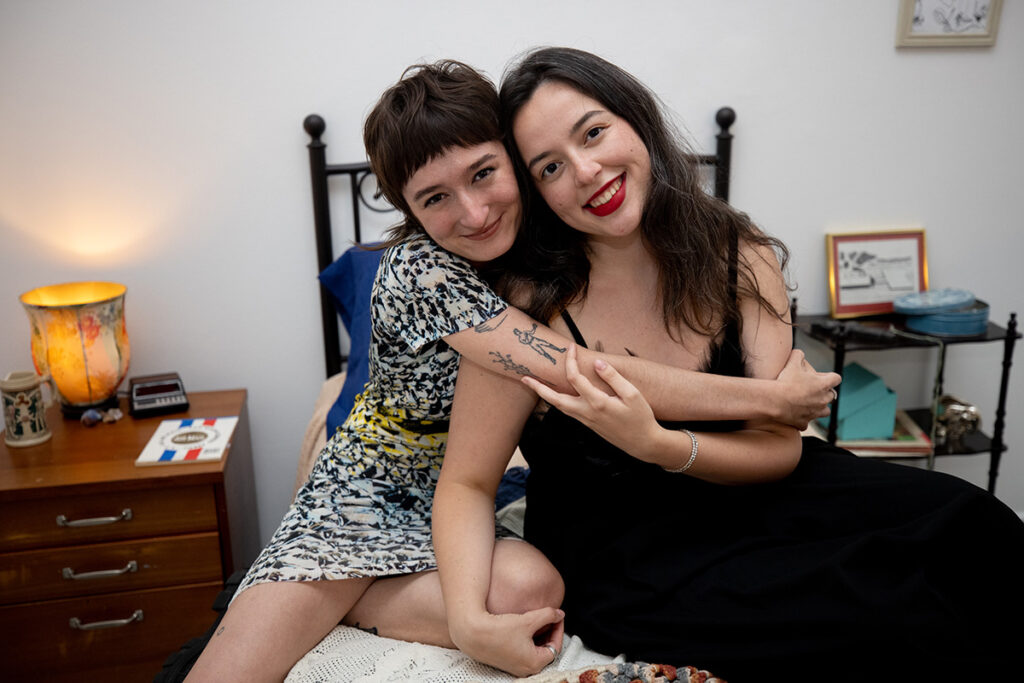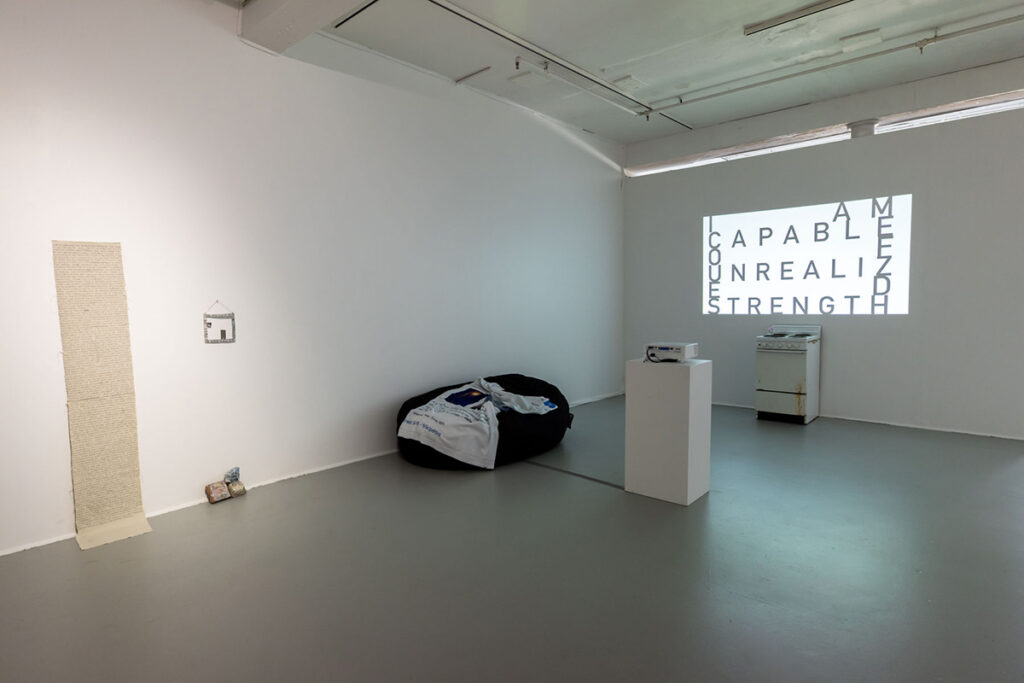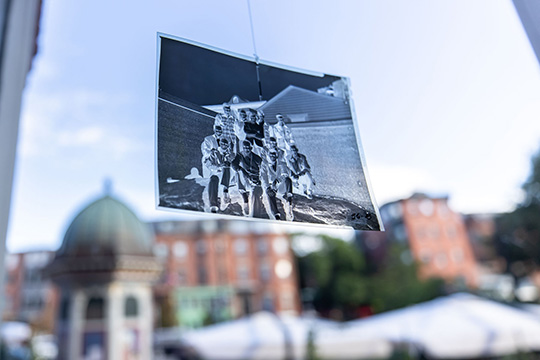With BCA Exhibit, Alums Open Doors to Intimate Space

Recent Emerson grads M’Kenzy Cannon ‘20 and Maya Rubio ‘20 have teamed up to create an intimate, interactive experience where visitors are encouraged to explore a stranger’s environment, and manipulate the space, both literally and figuratively.
The exhibit, PLEASE LET ME IN, is the fourth in the 1:1 Curatorial Initiative series at the Boston Center for the Arts’ (BCA) Mills Gallery. Cannon is the artist; Rubio is the curator of the exhibition.
Described as a piece of “object-spatial theater,” the installation features the interior of the home of an unknown stranger, where visitors are invited to pry and prod, “an opportunity to discover details hidden within the work and to reckon with what those discoveries might reveal,” according to the exhibit description.
PLEASE LET ME IN was inspired by a class that both Cannon and Rubio took as undergraduates at Emerson. IN402: Living Art in Real Space, is a multidisciplinary course taught by senior affiliated faculty members Brian Cronin and Mirta Tocci.
“This class really exploded my idea of what I could do,” said Cannon, “It was really inspiring.”

The course examines different art history movements from the early 20th century to now, using collaborative performance art as a method of experimenting with space and expression.
“It was such a good opportunity to think outside of the box in terms of what our art could be,” Rubio, a Business of Creative Enterprises major, said.
Cannon added that the class was also rewarding because it was interdisciplinary, meaning the students in the class often had different majors and interests. “The pressure was high and it was very intense,” said Cannon, who graduated with a BFA in Media Arts Production. “But it was really beautiful because you could draw ideas from WLP and performance and VMA.”
The course even inspired Cannon to throw ‘Living Art’ parties, where students from the class would meet outside of the classroom to perform with – and for – one another.
In fact, it was one of these parties that gave Cannon the idea for PLEASE LET ME IN. “I had about 20 people over, and we would all sit in my room, but nobody was hanging out. It was just kind of bizarre for me to have around 20 people come in and out of my bedroom,” she said.
The bedroom space, and the intimate interaction it inspires, is the foundation of PLEASE LET ME IN.
Conceptually, Rubio also drew inspiration from a course she took her senior year – VM415: Professional Curatorial Seminar: Curating Contemporary Art.
PLEASE LET ME IN is the first exhibit Rubio has ever curated. “I first had to figure out what it meant for me to be a curator,” she reflected. “I learned that the root of ‘curate’ is ‘care,’ so I always think of my curating practice as being caring towards [M’Kenzy]’s process, and towards the show in general.”
Cannon and Rubio have been working on the exhibit since February 2021, feeding off each other creatively.
“There were so many times where I had a piece or concept, and Maya was so amazing at curating in terms of knowing my work and my process and also just understanding the collective vision of the show so deeply that she was able to bring specific pieces into life,” Cannon said.

For example, when they were still figuring out how to best optimize their space in the gallery, Cannon was unsure where one of the video installations should go. She was having trouble deciding how it would function in the space, accounting for the size of the video projection.
While she was panicking, Rubio was searching for ideas on Facebook Marketplace. She eventually found a stove, which the pair decided would complement the space perfectly. “I’m so lucky I get to work with Maya,” Cannon said.
Cannon decided to exit the space when it came time for guests to experience it.
“It kind of defeats the purpose of having me there, watching you dig through my room, because it’s meant to be an intrusive thing,” she explained. Rubio agreed, adding that, “The last piece of the show is the guest. The show hinges on the interaction and the guests’ experience in the space.” The exhibit is meant for guests to physically, and emotionally, interact with it.
Rubio, however, has returned to the gallery twice since its opening. She talked about reading guests’ journal entries (an element of the exhibit) and observing the different ways in which they rearrange the various objects in the space. “It is just so fantastic,” she observed, proud of the positive, physical response to the exhibit.
Both Cannon and Rubio said they came away from their time working on PLEASE LET ME IN having learned a few lessons. For Cannon, simplicity is key. “Looking back at our original proposal, it is so vastly different in so many ways, physically speaking, because we had a lot of larger ideas, but over time it simplified and simplified into the most distilled version of what the show is about,” she explained.
Rubio’s takeaway was to trust the process. “You need to surrender to your future self and trust that you can’t be mad that you’re stuck,” she explained, “you have to just keep moving forward.” This also includes recognizing when you need to move on from ideas that may be bogging you down, according to Cannon.
The pair also acknowledges how helpful the BCA team was throughout the process. “They helped us believe in ourselves so much,” Rubio explained, “They were our first audience.”
PLEASE LET ME IN will run as part of the BCA’s 1:1 Curatorial Initiative until September 10.
Cannon and Rubio have also designed Desire Path with Kelly Chen, a sonic walk through Boston’s South End, as a way to highlight the collaborative relationship between an individual and the space they occupy. Desire Path also is set to run through September 10.
On August 30, the BCA will host Romancing the Virtual Domestic, a virtual poetry workshop with Annie Louise Martin, where participants can interact with the intimacies of their own bedroom, as an extension of the exhibit. And on the last day of the exhibit, both Cannon and Rubio are set to host a participatory performance workshop in the exhibit space, where guests can collaborate with the physical environment of the exhibit.
More information for Cannon and Rubio’s BCA events can be found at: https://bostonarts.org/experiences/.
Categories